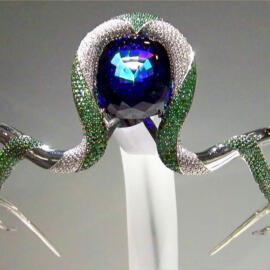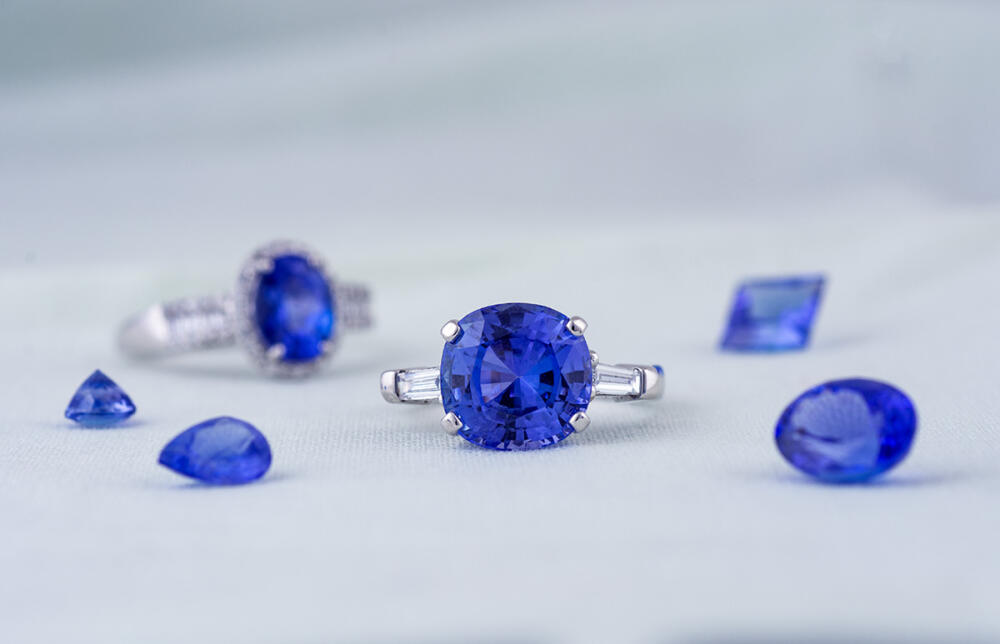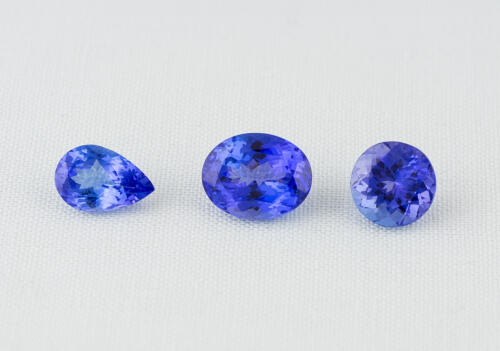Gem in the Spotlight: Tanzanite
Beautiful and Rare, Tanzanite Jewelry Makes a Great Impression
Beauty and rarity are two wonderful traits in a gemstone. Tanzanite has them both. In fact, it is estimated that Tanzanite is 1,000 times rarer than diamond. But, what makes Tanzanite so popular is its color.
Tanzanite’s gorgeous color is a captivating mix of blue and purple. The deep hues of violet, indigo, and blue come together in an unrivaled blend only found in tanzanite. Yet, even with its rarity and dynamic look, tanzanite is still less in price than more commonly known gems like rubies, sapphires, and emeralds.
Gemology of Tanzanite
Gemologists refer to this gem as blue zoisite. The vast majority (current estimates are around 95%) of tanzanite is heat treated to help bring out the vibrant blues. The stones that haven’t been heated by humans were heated through natural effects while they were still underground. Without heating, most tanzanite would be a brown color, similar to smoky quartz.
The very small percentage of tanzanite that isn’t heated and is still pretty enough for jewelry displays trichroism. Trichroism is an effect that causes gemstones to display different colors when viewed at different angles. Tanzanite in its raw form has three colors: blue, purple, and green. Heating removes the green component which makes the violetish blue color pop (although technically speaking it doesn’t make it more blue, just less green). The amount of blue in a tanzanite is caused by the quantity of vanadium present. Raw, unheated tanzanite is sometimes marketed as “mermaid tanzanite” because of the iridescent blue and green colors.
You can usually tell if a tanzanite has been heated by using a dichroscope. This is a tool that gemologists use to separate the pleochroic colors that a gemstone has. If there is a strong green component at any angle, then it likely has not been heated.
The main factors that influence the value of tanzanite are its hue and how deep the color is. Less important, but still part of the equation, are the cut and clarity. As with all colored gems, the value of tanzanite comes from its color.
Tanzanite has a Moh’s hardness of 6-7, making it about the same hardness as quartz, softer than ruby, sapphire and emerald and hard than opal. Tanzanite has a refractive index of 1.69-1.70.
History and Lore of Tanzanite
Tanzanite was originally discovered in 1967 in Tanzania, near Mount Kilimanjaro, by a Maasai tribesman named Ali Juuyawatu, although the credit often goes to an Indian prospector named Manuel de Sousa who Ali showed the stones to. Manuel had originally thought he found sapphires, but after discovering they were too soft, he started searching for answers as to what these gems could have been. They went to MIT geologists who discovered the gems were blue zoisite. Eventually, as the stones made their way through identification channels they found their way to the Henry B. Platt, the VP of Tiffany & Co. at the time, who named the stone tanzanite after the country of origin. Tiffany then started marketing the stone around 1968.
The geological conditions required to form tanzanite are quite rare, leading some geologists to believe that it may become extremely scarce in the future, further driving its desirability. Tanzanite is currently one of the rarest gemstones, and it is only found in one place on earth.
In 2002 tanzanite was added as one of the birthstones for December alongside blue zircon, turquoise, and blue topaz.
Tanzanite is believed to symbolize transformation and spiritual awakening. It is often associated with the idea of personal growth and enlightenment, helping individuals connect with their higher selves. It is also believed to signify new beginnings which makes it a great gift for weddings, births, and graduations
Notable Tanzanite Gems

The Mawenzi Tanzanite is the largest rough tanzanite in the world, weighing around 6 pounds (over 13,000 carats!). Discovered in 2005, it has dimensions of 218.44x 80.01 x 71.12 mm. Its name is inspired by the second-highest peak of Mount Kilimanjaro. The Mawenzi Tanzanite is expected to stay in Tanzania for cutting and polishing, with the best pieces eventually showcased at the Tanzania National Museum.
The Queen of Kilimanjaro tiara contains the largest faceted tanzanite in the world. The tiara also contains 913 diamonds and 803 tsavorite garnets all set in 18 karat white gold. It is owned by former Apple CEO Michael Scott who routinely loans it out for display at museums.
Care and Cleaning of Tanzanite
While tanzanite is stable and won’t be harmed under normal conditions the low hardness and poor to fair toughness (and a property called cleavage, which is a tendency to break when struck) means that care should be taken to avoid sharp impacts. Setting it in earrings or a pendant will help protect it if the intended use is daily wear. Rings and bracelets set with tanzanite should only be worn carefully on occasion.
We recommend cleaning with warm soapy water and a soft bristle brush. You should never clean your tanzanite in an ultrasonic cleaner or steamer.
As if the amazing color of tanzanite wasn’t enough incentive to collect them, there is more to the story. In 2019, the Tanzanian government closed the only large-scale tanzanite mine in the world. There are a few smaller-scale mines still operating, but their combined output doesn’t come close to that of the primary mine. All of this means that the scarcity of tanzanite is only expected to increase.
So, should you get a piece of tanzanite jewelry? Our advice would be to buy jewelry that you love to look at. No one knows what the future holds for the markets, but when you buy a high quality piece of tanzanite, you know for sure that it will look absolutely amazing. When you are ready to find your perfect pieces of tanzanite, we would love to help. Reach out to us anytime.


This page was written in a comfortable, easy style and was very informative. I’m looking forward to reading more.
Thanks for the kind words. You may also like the rest of the Gem in the Spotlight series.